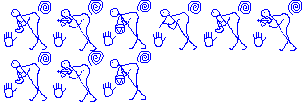Back to Day 9

I first made the drive from Crownpoint to Cuba in the summer of 1979. Steve and I had become seriously interested in photography the year before and had taken a photography class at the Tucson Museum of Art. Our son, David, had actually pushed us in this direction. Steve and I had both developed and printed our own photographs when we were in high school, but we had not even had a decent camera in the whole time we had been married. David was very intrigued with photography, so we all took the photography class together. At the same time I was deeply involved in writing software to analyze the surface brightness profiles of galaxies for one of the first image processing systems used in astronomy. This proved to have a strong influence on the images I was to "see" and to put on paper. Steve and I took a course in the History of Photography at the University of Arizona and saw many images that we would no longer have to make for ourselves and gained a much deeper perspective on image making. We would take a studio course the next year.
But, as to being at Crownpoint, we had decided to take a long vacation by car on which we would photograph for six weeks while driving from Tucson across the southern part of the US, up the east coast into Canada, through New Brunswick, Nova Scotia, the Gaspé Penninsula, then across Quebec, Ontario, and westward until we reentered the US in Montana at a crossing where we had to roust the crossing guard from the fields to look at our documents showing that we had had our cameras with us before leaving the country. Then we drove down the Rockies to Laramie, where we spent a few days with friends, and then drove home to Tucson. The first day was the standard first day out, shifting mental gears. The second day was different. We picked up some hitchhiking Hopi girls who were about David's age. The car they had been in, on the way to the dances which we did not have sense enough to go see, ran out of gasoline. They left the boys they were with and started walking. When we came by, they stuck out their thumbs. So the back of our VW bus was filled with four giggling Hopi girls and one Anglo boy who didn't know how to talk to them. Of course, it probably didn't matter at all that they were Hopi and he wasn't. They were teenage girls who had deserted their dates when the gas ran out and he was the only boy around. The giggling just was a natural part of the scene.
We drove the girls to the top of First Mesa, above Polacca, and into a shoulder to shoulder crowd. If I had known then what I know now, I would have parked (somehow) at the small level space below the top and walked up with the girls and gone to see the katchina dances. Instead we drove on up, at their urging, and they got out. We then had to figure out how to get back out. I don't know how we did it, but it was at well below 5 mph. Thirteen years later, I happened to be camping at the Second Mesa campground when a Hopi patrolman told me that there were dances at First Mesa the next day, and that I was welcome to go. I woke up at dawn, had breakfast as soon as the restaurant opened (the only place I know of where you can buy piki bread), talked with a visiting Navajo man who hoped to sell some crafts to the crowd, and drove over to First Mesa for the dances. I remained the entire day in the presence of the gods.
But in 1979, we then drove over to Window Rock, hoping to camp there. It was still relatively early and a campsite in the middle of town didn't appeal to us. We decided that there must be a campground easily found not far inside the New Mexico border, so we drove on. We wanted to be in Los Alamos tomorrow night and we didn't want to take the Interstate if we could avoid it. On looking at the New Mexico map, we saw a road that ran parallel to the Interstate from US 666 to NM 44 at Cuba. Chaco Canyon National Park was just off this road. At worst, we would find a spot there. So we turned onto this road. Distances always seem to be 2-3 times farther than they appear to be on New Mexico road maps. David had just obtained his learner's permit and was driving on this road (no other traffic, should be safe!). After Crownpoint, we found the road was no longer paved. Well, we were used to that; no problem. Besides, we had no choice now. Onward. There were no likely camping spots near the road, and it was starting to get dark and hard to see the landscape. We came to the turnoff for Chaco Canyon. The sign said the campground was over 20 miles away over a rough dirt road. We decided there would surely be an easier place to camp. So onward. Well, David didn't think that road would ever end. I vaguely remember, while being bounced around in the back of our VW bus, driving slowly through Torreon, looking for the right road out. All the way to Cuba we worried that we had taken the wrong road. We finally got to the highway and found a small motel in which we collapsed after the tension of the drive.
That drive was only the first of the special David drives on our 1979 trip.
© 1994, 2000 Karen M. Strom
Back to Day 9
